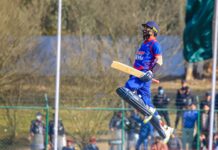On 14 June, the same day that the USA will take on Ireland at Lauderhill in the Men’s T20 World Cup, New Zealand play Uganda in Trinidad, and South Africa meet Nepal in St Vincent, hosts Germany will kick off the 2024 European Football Championship against Scotland at the Allianz Stadium in Munich.
The opening phase of the Euros comprises six groups of four teams, and the composition of those groups was decided at a public, televised ceremony in Hamburg on 2 December last year, which attracted a large TV audience of excited fans.
Although the placing of teams into the groups involved pulling balls out of four pots, the contents of each pot were based on the current UEFA rankings, which were also a matter of public record.
By the same token, the draw for the 2023 Rugby World Cup was a public event, again based on the published rankings at the time.
> More on the T20 World Cup schedule
That’s the way most sports organise such matters, quite rightly believing that such a transparent process is a minimum requirement for an honest and equitable international event.
The ICC, though, does things differently.
Even if we concede that there might be less interest in a televised draw for a global cricket tournament – and that is, to say the least, very far from being self-evident – one might expect that the rationale for the allocation of teams to groups would be based on visible factual criteria.
The T20 World Cup organisers might, for example, have taken the current team rankings to seed the 20 teams, or they could have used the final positions from the 2022 tournament as a starting point and then used the rankings to place the teams which did not take part in that event.
But neither of those systems would by any stretch of the imagination have put India and Pakistan in the same group, or England and Australia, or indeed, Canada and the USA.
One might almost gain the impression that the starting point for these groups was the pencilling in of a number of apparently desirable fixtures, and that the organisers then worked back from there, taking care to ensure that certain favoured teams were given the best possible chance of going through to the Super Eight.
There might be transparency here, but it’s not the sort of transparency you get from an open draw; it’s the transparent desire to maximise profit and television and digital numbers at the expense of any pretence of caring about the competition as an honest sporting event.
Having said all of that, the hocus-pocus of this pseudo-draw has given the Netherlands, who famously qualified directly for this tournament by beating Zimbabwe and South Africa in 2022 to finish in the top eight but have nevertheless been dumped in the bottom eight of these groups, an appetite-whetting schedule and at least an outside chance of once again defying the odds and making it through to the Super Eight.
It’s true that they will have to play at four different venues, two of them a six-hour plane journey apart in the USA and the other two in separate Caribbean countries, but coach Ryan Cook and captain Scott Edwards will relish the fact that their opponents are South Africa, Sri Lanka, Bangladesh and Nepal.
It goes without saying that they will have to play at their best to finish in the top two of their group, but the fact that they have beaten South Africa in two different formats in the last two World Cups and that Bangladesh was their other scalp in the recent 50-over World Cup gives them every reason to approach their campaign positively.
Sri Lanka are, of course, another matter: the Dutch have never beaten the Lions in any format and their last two meetings in the T20 World Cup, in 2014 and 2021, saw them bowled out for 39 and 44, but they showed during last year’s World Cup Qualifier in Zimbabwe that they have the potential to break that run if their batters can find a way of mastering the Sri Lankans’ potent mix of pace and spin.
They will begin their programme, though, at the Grand Prairie Stadium in Dallas, where they will face a possible banana-skin in Nepal.
These are sides which know each other pretty well, and they’ll know each other even better after the Nepalis host a League 2 ODI tri-series and a T20I series against the Netherlands and Namibia in Kirtipur in February-March.
That may prove something of a form guide as well as valuable material for the teams’ planning, although it must be said that Kirtipur at almost 1350 metres above sea level is a far cry from Dallas, Texas.
The Dutch party will then move to New Amsterdam York to take on South Africa at the temporary Nassau County International Cricket Stadium (a.k.a. Eisenhower Park), where they will attempt to make it three wins in a row against the Proteas.
To beat the South Africans once was remarkable; repeating the dose at Dharamsala was extraordinary; to do it a third time would be little short of earth-shattering.
But Ryan Cook’s meticulous planning, based on his insider’s knowledge of South African cricket and backed up by that of several members of his likely squad, means that such an outcome is at the very least entirely imaginable.
From the Big Apple it’s on to Arnos Vale, St Vincent for another loaded rematch, this time against Bangladesh.
The last time these teams met in a T20I, in the first phase of the 2022 World Cup, the difference was just nine runs, and the Dutch came away knowing that it was a game they could, and arguably should, have won.
They are a much better side now than they were then, as they proved with their comfortable victory in the 50-over World Cup in Kolkata last October, and we can expect this match to be a rare tussle.
And so to Gros Islet, St Lucia, and the Darren Sammy Cricket Ground, to face Sri Lanka in what could prove to be a do-or-die encounter with Sri Lanka.
Much will depend, as always, on the composition of the Dutch squad, and on how many first-choice players it has been possible to prise from the grasp of the English counties.
But Scott Edwards and his men have repeatedly demonstrated over the past two years that they are a force to be reckoned with, and it should surprise no-one if they are still in the mix when the Super Eight phase gets under way.
You’re reading Emerging Cricket — brought to you by a passionate group of volunteers with a vision for cricket to be a truly global sport, and a mission to inspire passion to grow the game.
Be sure to check out our homepage for all the latest news, please subscribe for regular updates, and follow EC on Twitter, Facebook, LinkedIn and YouTube.
Don’t know where to start? Check out our features list, country profiles, and subscribe to our podcast. Support us from US$2 a month — and get exclusive benefits, by becoming an EC Patron.







